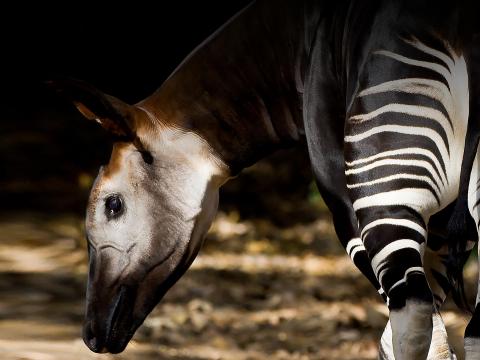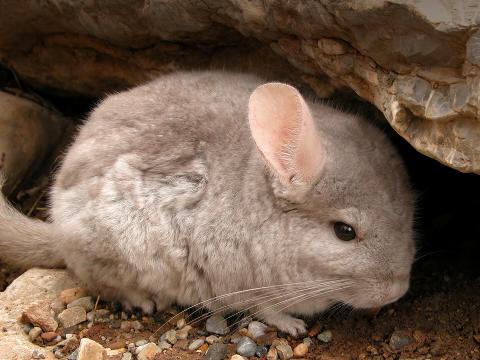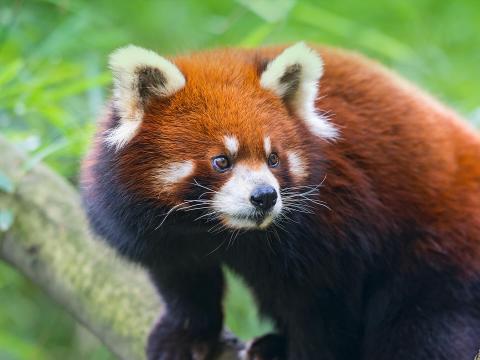Hamadryas Baboon
- CLASS: Mammalia (Mammals)
- ORDER: Primates
- FAMILY: Cercopithecidae
- GENUS: Papio
- SPECIES: hamadryas
ABOUT
This baboon is no buffoon: Once revered by Ancient Egyptians as representatives of the Egyptian god of learning, hamadryas baboons are also referred to as Sacred Baboons. These hardy Old World monkeys display complex social behaviors, and can live in troops of several hundred individuals. Though currently extinct in Egypt, these monkeys can be found in large populations in Ethiopia, Somalia, Saudi Arabia, and Yemen. In fact, no other kind of baboon resides as far north as hamadryas baboons. The remarkable silver manes and pink faces of adult males add to the unique nature of these intelligent primates.
Hamadryas baboons are large-bodied monkeys with a strong build and a dog-like muzzle. Both males and females have brown or light gray fur. While the females have hairless black and brown faces, the male hamadryas baboon has a distinctive mantle (mane) of long silvery hair and a bright pink face and backside. These baboons sport a relatively short, tufted tail that is not prehensile.
Hamadryas baboons are diurnal, meaning that they are active during the day. After awaking around sunrise, troops of several hundred baboons will come together to "monkey around." This includes chasing, playing, and social grooming within their "One Male Unit" (OMU) social group. Afterward, their work begins. The troop leaves the sleeping site, breaks off into smaller groups called bands, and the bands separate into OMUs to forage for food. The troop reunites in the afternoon for a water break, especially during dry times. Then, it’s back to more foraging in OMU formations. As the sun sets, the groups return to the sleeping site, and the monkeys coalesce once again for more social grooming before it is time for bed.
Although staring contests and lip-smacking may seem like trivial, if not amusing, ways of interacting with our friends, these behaviors have completely different meanings to hamadryas baboons. In fact, staring is considered a threat behavior! Other threat behaviors include tension yawns, during which a baboon’s canine teeth are clearly exposed, as well as head bobbing. But fear not, these baboons have behaviors known to comfort one another as well. Social grooming is extremely important for building relationships. Teeth-chattering and lip-smacking are considered reassurance behaviors, and are usually performed by dominant males as a sign of comfort. Dominant males may also produce a two-phase bark to ward of predators and other male baboons.
Hamadryas baboons belong to a group of monkeys found in Africa and Asia. There are many physical differences between monkeys native to Africa and Asia and those native to the Americas. Hamadryas baboons have characteristics typical of monkeys native to Africa and Asia like non-grasping (or prehensile) tails, they are primarily terrestrial, and they have opposable thumbs that are very similar to a human's thumb. These traits are rarely seen in monkeys that live in the Americas.
Hamadryas baboons can fall prey to leopards, hyenas, and Verreaux’s eagles; however, many wildlife that may have been natural predators to the baboons historically no longer exist within the baboons’ habitat. Hamadryas baboons rely on assembling into large groups for protection. Groups are largest while getting water and sleeping, as these are times when baboons are most vulnerable. As another level of security, troops of baboons favor sleeping in high places.
HABITAT AND DIET
Hamadryas baboons live in diverse habitats ranging from subdesert to savanna and into steppe, plains, and arid brushland. Rather than trees, these primates prefer to live near high cliffs where they can gain access to acacia, opuntia cactus, and a water source.
Hamadryas baboons forage for food by day in One Male Units (OMUs) made up of a small group of monkeys from the larger troop. At night, the smaller groups coalesce at the sleeping site to form troops of several hundred individuals. Sleeping sites are often located on cliff sides, but hamadryas baboons will also occasionally find shelter in trees. Above all else, these monkeys make sure to find a home near water.
The hamadryas baboon is omnivorous; however the majority of its diet consists of plant matter. Hamadryas baboons in Africa and Arabia share a similar diet to some extent: both populations primarily eat grass seeds, roots, berries, and the flowers, leaves, and pods of acacia trees. Baboon populations in Arabia commonly eat cactus fruit and palm nuts, as well. Non-plant food sources make up a small portion of their diet and include bird eggs, carrion, small mammals, and occasionally insects like locusts. Since most baboons live in arid environments, they are able to survive on low-quality diets for long periods of time in their native habitat.
FAMILY LIFE
Hamadryas baboons have a polygynous mating system, where the dominant male mates with more than one female. Within these social groups, called One Male Units (OMUs), females bond with males by grooming the male leader of their unit. This is where the male’s mantle (mane) comes into play, as it seems that grooming behaviors are exclusively focused on the male.
Females give birth to one baby at a time. For the first 3 weeks of its life, a baby will hold onto its mother by gripping her hair as she moves around. Hamadryas baboon babies have pink skin and black hair until they are one year old, at which point their hair turns brown and resembles that of the adults.
Males begin to establish their own units when they are between 4 and 6 years old, while females begin looking to join an OMU between the ages of 4 and 5. Female members of OMUs may change groups depending on changes in male dominance, which occurs often. Multiple OMUs will often work together forming a group called a band, hence, they "band together" at night to share sleeping sites. These groups are called troops and can include hundreds of individual baboons.
CONSERVATION
Hamadryas baboons are listed as a species of Least Concern on the IUCN Red List of Threatened Species. They exist in stable, even growing populations. Once collected in great numbers for medical research, they currently face only a few localized threats. Their range often overlaps urban and agricultural areas. While these monkeys are commonly tolerated by humans, they are occasionally considered a pest, as they can destroy crops and can become aggressive when approached. As agricultural and irrigation development continues to expand, it may result in greater conflict with humans as well as habitat loss.










